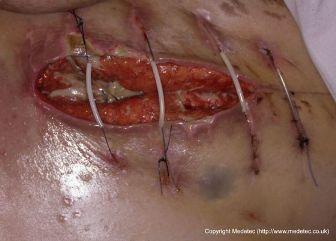What Is Wound Dehiscence?
March 8, 2016
By the WoundSource Editors
Wound dehiscence is a distressing but common occurrence among patients who have received sutures. The condition involves the wound opening up either partially or completely along the sutures – basically, the wound reopens to create a new wound.
Causes of Wound Dehiscence
Wound dehiscence is always a risk. The patient's health, the amount of physical activity impacting the wound site, the wound location, and the physician's skill all increase or decrease the chances of wound dehiscence. However, everyone is at risk of this condition, no matter how healthy the person may be.
Wound dehiscence can be accidental or done intentionally. If a sutured wound becomes infected, for example, physicians may have to surgically reopen the wound to debride the wound of infected tissue; this is a form of dehiscence.
However, most cases of wound dehiscence are accidental. This can be due to excessive pulling or pressure causes the two sides of the wound to separate, or because the suturing work was not done well and stitches have broken. Sutures that are located over joints or on parts of the body with increased movement can break if the joints bend and stretch the surrounding wound tissue too much.
The suture site can also suffer as a side effect of an underlying health condition that affects the immune system or healing ability. For example, AIDS and diabetes can both increase the chances of wound dehiscence.
How to Tell if a Wound is Dehisced
A dehisced wound can appear fully open – the tissue underneath is visible – or it can be partial, where just the top portion of the skin has torn open. The wound could be red around the wound margins, have drainage, or it could be bleeding or seeping, where only a thin trickle of blood is coming out. The wound will likely be painful and may become increasingly so. The wound might also look moist well after the sutures have been added. Some wound tissue may appear to be necrotic.
Patients should also be aware that even if the wound looks like it is healing properly, if any of the stitches are broken, that could be a sign the wound either has minor dehiscence or is about to dehisce.
How to Treat a Dehisced Wound
Much of the treatment for a dehisced wound is similar to the treatment for a new wound: any infection must be treated with antibiotics, dead tissue must be removed (possibly debrided), and the wound needs interventions to support closure. If a clear cause why the wound dehisced can be established, these factors must be addressed.
For example, if the original sutures were not done properly, the new ones need to be done well. If the wound dehiscence was due to the sutures being located right over a joint like the elbow, the joint needs to be immobilized as much as possible. If the wound dehiscence is due to an immune or healing issue, then the wound needs to be monitored more closely to ensure any new signs of dehiscence are identified before the wound actually reopens.
Preventing Wound Dehiscence
To prevent wound dehiscence, the patient must follow all post-suture instructions carefully, particularly any instructions regarding when the wound site can get wet. The patient must move carefully and protect the wound site from anything that could cause friction or pull the skin around wound site. Patients should report any redness or new pain, or pain that doesn't get better, as soon as possible so that a physician can verify whether or not the wound is still healing properly. The patient also has to take care not to tense muscles excessively, such as when the patient lifts a heavy object. Wound dehiscence can occur suddenly, and it important for patients to follow physician instructions carefully and minimize activities that may potentially impact the wound site until wound is well on its way to healing completely.
Image Credit: Medetec (www.medetec.co.uk)
The views and opinions expressed in this blog are solely those of the author, and do not represent the views of WoundSource, HMP Global, its affiliates, or subsidiary companies.









Follow WoundSource
Tweets by WoundSource